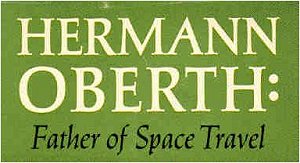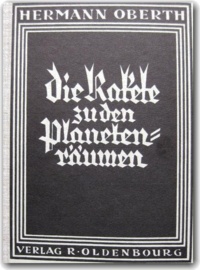 www.kiosek.com/oberth
In 1923, the year after the rejection of his dissertation, he published the 92 page Die Rakete zu den Planetenraumen (The Rocket into Planetary Space). This was followed by a longer version (429 pages) in 1929, which was internationally celebrated as a work of tremendous scientific importance. That same year, he lost the sight in his left eye in an experiment while working as a technical advisor to German director Fritz Lang on his film, “Girl in the Moon.”
www.kiosek.com/oberth
In 1923, the year after the rejection of his dissertation, he published the 92 page Die Rakete zu den Planetenraumen (The Rocket into Planetary Space). This was followed by a longer version (429 pages) in 1929, which was internationally celebrated as a work of tremendous scientific importance. That same year, he lost the sight in his left eye in an experiment while working as a technical advisor to German director Fritz Lang on his film, “Girl in the Moon.”
In the thirties Oberth took on a young assistant who would later become one of the leading scientists in rocketry research for the German and then the United States governments; his name was Wernher von Braun. They worked together again during the Second World War, developing the V2 rocket, the “vengeance weapon” for the German Army, and again after the war, in the United States at the U.S. Army’s Ballistic Missile Agency in Huntsville, Alabama. However, three years later Professor Oberth retired and returned to Germany. (
more)
___

 Early Days of Rockets and Aeronautics
Notes on Hermann Oberth
Space Pioneer Hermann Oberth was Von Braun Mentor
Early Days of Rockets and Aeronautics
Notes on Hermann Oberth
Space Pioneer Hermann Oberth was Von Braun Mentor

>
wikimedia.org
Oberth with Wernher von Braun in Berlin
Space pioneer Hermann Oberth, was considered by many to be the most famous mentor of the late Dr. Wernher von Braun, the first director of the NASA Marshall Space Flight Center in Huntsville, Alabama. "On the German side, I have to mention before all Professor Hermann Oberth who offered the world new basic concepts in the field of rocket technology," Von Braun wrote in 1959.
Oberth was born in Hermannstadt (
Sibiu rom.), Transylvania, the son of Dr. Julius Oberth, a physician. He attended schools at Schaessburg (
Sighisoara rom.), Transylvania, until he was ready to enter the University of Munchen in 1913. He later became a professor of mathematics and physics.
(
Note by Harsi: Transylvania was for many centuries until the end of WW I part of the Austria-Hungarian Empire were many people of German origins lived and the cities and villages all had German or Hungarian names. When Transylvania (Siebenburgen is the German name) became part of Romania after WW I they all got a Romanian name)
For two years (1928-30) he experimented with gasoline and liquid air as a rocket propellant while working as an advisor to the film company making the space-oriented film "Girl in the Moon." In the spring of 1930, a young Wernher von Braun enrolled at the Berlin Institute of Technology and in his spare time assisted Oberth in his early experiments in testing a liquid-fueled rocket stage with about 15 pounds of thrust.
In September 1930, Oberth returned to a teaching post in Romania while von Braun continued experiments under the sponsorship of the German Society for Space Travel. Oberth rejoined Von Braun and his team of scientists working on rockets at Peenemuende during World War II. After the war, his research continued, and for a time he was engaged in rocket research for the Italian navy.
In 1955, he was invited to rejoin the rocket team. This time, Oberth came to Huntsville where he pursued rocket studies in the Technical Feasibility Studies Office of the U. S. Army Ordnance Missile Laboratories. In 1956, he transferred to the Army Ballistic Missile Agency as chief of Special Fields in the Research Projects Office. He resigned from U. S. government service in November 1958 and returned to Germany.
Von Braun later claimed that Oberth's book, "A Rocket to the Interplanetary Space," which was published in 1923, gave "proof that it was possible to travel to other planets by means of liquid propellant rockets."
Oberth, who visited the Marshall Center as recently as 1985, is also remembered by others in Huntsville. Bill Snoddy, now retired from the Marshall Center, went to work for the Army in Huntsville in 1958. Snoddy recalls that crowded conditions meant that many new employees ended up with their desks in the hallway of Bldg. 4484. "My desk was outside Professor Oberth's office," Snoddy said. "I was new and was only around him for a few months before he went back to Germany. But I remember that he was a very quiet person. He was very humble."
Snoddy also remembers seeing the many charts and exotic illustrations in Oberth's office: "He was a visionary. Like Von Braun, he could communicate his ideas in drawings and writings." Recalling Oberth's close association with Von Braun, Snoddy said, "If Von Braun can be considered the father of the space age, then Oberth must be the grandfather."
Hermann Oberth died Dec. 29, 1989, in a hospital in Nuremberg, West Germany (
more)

 > Photo Gallery: Heavenly Eating for the ISS
> Photo Gallery: Heavenly Eating for the ISS 





 >
>  >
>  >
> 
 >
> 





 >
>  (Picture: Hermann Oberth, NASA)
(Picture: Hermann Oberth, NASA) “
“ >
>  >
> 
 >
>  >
> 
 Spaceship Design Drawings:
Spaceship Design Drawings: >
>  >
> 



 >
>  >
>  >
> 